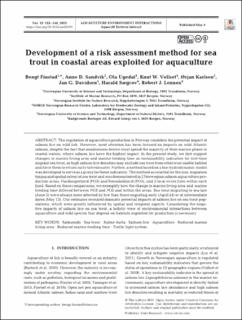Development of a risk assessment for sea trout in coastal areas exploited for aquaculture
Finstad, Bengt; Sandvik, Anne Dagrun; Ugedal, Ola; Vollset, Knut; Karlsen, Ørjan; Davidsen, Jan Grimsrud; Sægrov, Harald; Lennox, Robert J.
Peer reviewed, Journal article
Published version
Permanent lenke
https://hdl.handle.net/11250/2762305Utgivelsesdato
2021Metadata
Vis full innførselSamlinger
- Articles [3012]
- Publikasjoner fra CRIStin [3070]
Sammendrag
The regulation of aquaculture production in Norway considers the potential impact of salmon lice on wild fish. However, most attention has been focused on impacts on wild Atlantic salmon, despite the fact that anadromous brown trout spend the majority of their marine phase in coastal waters, where salmon lice have the highest impact. In the present study, we first suggest changes in marine living area and marine feeding time as sustainability indicators for first-time migrant sea trout, as high salmon lice densities may exclude sea trout from otherwise usable habitat and force them to return early to freshwater. Further, a method based on a bio-hydrodynamic model was developed to serve as a proxy for these indicators. The method accounted for the size, migration timing and spatial extent of sea trout and was demonstrated in 2 Norwegian salmon aquaculture production areas, Hardangerfjord (PO3) and Romsdalsfjord (PO5), and 2 focal rivers from within each fjord. Based on these comparisons, we exemplify how the change in marine living area and marine feeding time differed between PO3 and PO5 and within the areas. Sea trout migrating to sea late (June 5) were always more affected by lice than those migrating early (April 24) or at intermediate dates (May 15). Our estimates revealed dramatic potential impacts of salmon lice on sea trout populations, which were greatly influenced by spatial and temporal aspects. Considering the negative impacts of salmon lice on sea trout, a holistic view of environmental interactions between aquaculture and wild species that depend on habitats exploited for production is necessary.
